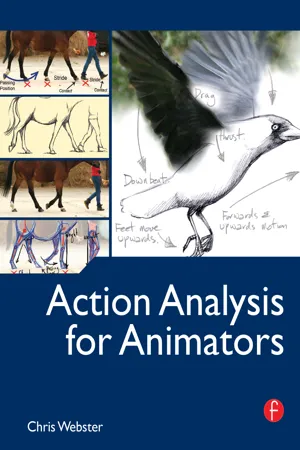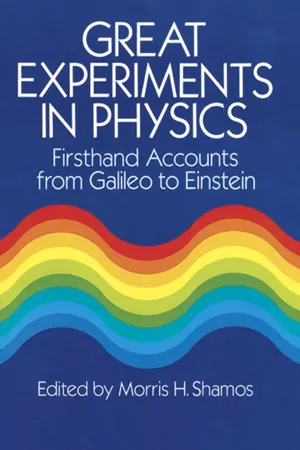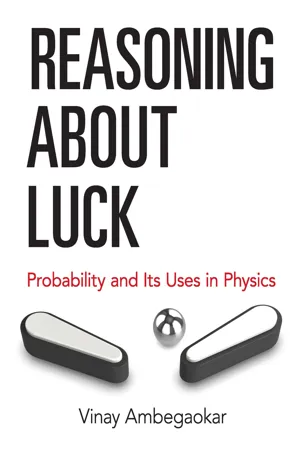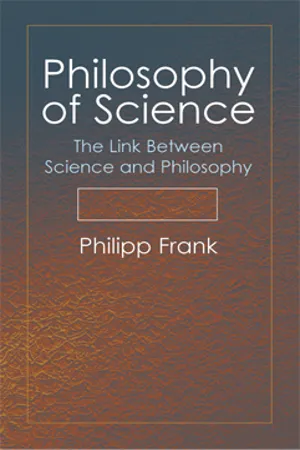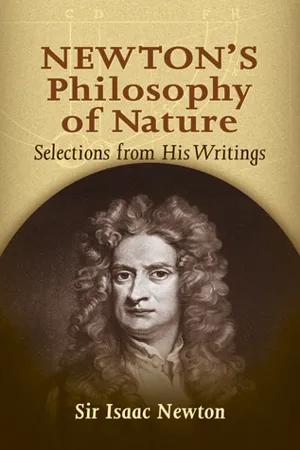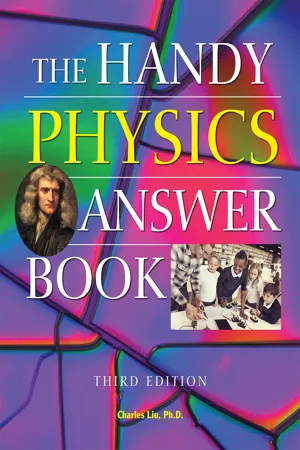Physics
Newton's Laws
Newton's Laws of Motion are fundamental principles in physics. The first law states that an object at rest will remain at rest, and an object in motion will remain in motion unless acted upon by an external force. The second law describes how the force acting on an object is related to its mass and acceleration. The third law states that for every action, there is an equal and opposite reaction.
Written by Perlego with AI-assistance
Related key terms
11 Key excerpts on "Newton's Laws"
- eBook - ePub
- Chris Webster(Author)
- 2012(Publication Date)
- Routledge(Publisher)
These laws describe the relationship between the forces acting on a body and the motion of that body. They are physical laws that form the basis for classical mechanics and are used to describe the motion of larger objects, whereas the motion of subatomic objects and material is described in terms of quantum mechanics. The laws that underpin classical mechanics are capable of producing highly accurate and predictable results; it is on this predictability that our engineering and technology are built and that provides us with a basis for our analysis of movement.Newton outlined the laws of motion that, along with his work on universal gravitation, explained the findings of the German astronomer and mathematician Johannes Kepler with regard to Kepler’s work on the motion of planets. Newton went on to use these laws to investigate the motion of many other subjects.Newton asserted that all forces should not be seen as remote and divorced from objects and that any given force is dependent on the interactions between objects. As a result, there can be no unidirectional forces; they are all determined by the location of objects and their relationships to one another, as we shall see when we cover Newton’s third law of motion.Newton’s three laws can be outlined as follows:- First law. An object will remain at rest until a force acts on it.
- Second law. An object will accelerate proportionately to the force applied to it.
- Third law. For every action there is an opposite and equal reaction.
There should be no need for us to get bogged down with any formulas that fully explain these laws, but I think by adding a little more detail we would gain some benefit. So let’s do that.Newton’s First Law of Motion
Newton’s first law of motion simply reflects what others before him had already observed: An object at rest will remain at rest until a force acts on it. That idea would seem to be pretty straightforward and observable in our everyday experience. If we don’t pick up the coffee cup, for example, it is likely to remain where we placed it. It is for this reason that Newton’s first law of motion is also often referred to as the law of inertia - eBook - ePub
Doing Physics with Scientific Notebook
A Problem Solving Approach
- Joseph Gallant(Author)
- 2012(Publication Date)
- Wiley(Publisher)
Chapter 5Newton’s Laws of Motion
In the previous chapters on kinematics, we described motion in a quantitative sense. Once we know an object’s acceleration, we can describe its motion in terms of position, velocity, and time. Knowing how its motion changes lets us calculate how far, how fast, and how long the object moves.Now we move to a branch of physics known as dynamics. Dynamics is the study of the effects of forces on an object’s motion. Dynamics explains changes in motion by relating the cause of the changes (forces) to the effect (acceleration). Newton’s Second Law provides the rule relating the acceleration to the net force.There are three ingredients to Newton’s Second Law: the object’s acceleration, mass, and the net force acting on it. As we discussed in Chapter 2, the object’s acceleration is the rate of change in its velocity. Mass is a property of the object that determines how much change the net force produces. An object’s mass tells you how difficult it is to change its velocity and how much matter it has.A force is a push or a pull that can cause changes in motion. Forces are vectors, so they have magnitude and direction. This is consistent with your experience. When you exert a force on something, two things matter: how hard you push or pull and which way. Often objects have more than one force acting on them. The net force acting on an object is the vector sum of all the forces acting on it.Newton’s First Law
Newton’s First Law tells us what happens when there is no net force acting on an object.Newton’s 1st Law: An object will remain in a state of rest or continue in motion at a constant velocity unless compelled to change by a non-zero net force.When there is no net force acting on the object, there is no change in the object’s velocity. If it is at rest, it remains at rest. If it is moving, it keeps moving at constant velocity. Since velocity is a vector, constant velocity means no change in both speed and direction. Motion at constant velocity is motion in a straight line at a constant speed. - eBook - ePub
- Hiqmet Kamberaj(Author)
- 2021(Publication Date)
- De Gruyter(Publisher)
To describe a force, we can use its net effect on an object, such as the force capability to change the object’s shape or its position and accelerate or decelerate the object. These effects are described by the laws of the motion introduced by Sir Isaac Newton (1642–1727).Newton’s laws
Every body continues in its state of rest, or uniform motion in a straight line, unless compelled to change that state by forces impressed upon it. The change of motion of an object is proportional to the force impressed upon it and made in the direction of the straight line in which the force is impressed. To every action, there is always opposed an equal reaction; or, the mutual actions of two bodies upon each other are always equal and directed contrary.In mechanics, Newton’s laws are formulated in what is known as Newton’s first law of motion, Newton’s second law of motion, and Newton’s third law of motion, respectively. In this chapter, we will examine each of these laws in detail, and then give some simple illustrations of their use.It was first Aristotle, then after him Galileo, who recognized that the motion of an object is because of the forces exerted upon it, and because of an external cause its motion stops. That was then perfected by Descartes, who added that the motion must be in a straight line, which is formulated in terms of Newton’s first law, which states that, if there are no external forces exerted on an object to disturb its motion, then the object moves with constant velocity.Newton’s first law of motion
If an object is at rest or moving along a straight line with uniform speed, then it will remain at rest, or it will continue moving along the straight line with constant speed unless an external net force is applied on it to change its existing state of motion.Thus, if no forces are acting on the object, then its acceleration is zero. In other words, if no force acts to change the object’s motion, then its velocity remains constant. Based on the first law, we can say that any isolated object is either at rest or moving with constant velocity along a straight line. Here, an isolated object is the one that does not interact with its environment. - No longer available |Learn more
- Robert A. Pelcovits, Joshua Farkas(Authors)
- 2023(Publication Date)
- Barrons Educational Services(Publisher)
3Newton’s Laws
Learning Objectives
In this chapter, you will learn:Newton’s three laws of motionMass vs weightApplication of Newton’s lawsNewton’s first law:Stated in words: When the net force acting on a body is zero, its acceleration must be zero, meaning that the velocity remains constant. This corresponds to two physical situations: (1) the object can either remain at rest (v = 0) or (2) continue along a straight-line path at constant velocity (v ≠ 0).Superposition of Forces What do we mean by net force? What happens if we exert several forces on a body at the same time? We find experimentally that the body behaves as if a single force is acting on it equal to the vector sum of all the individual forces (we call this vector sum the net force, Fnet ).The superposition of forces also works the other way, letting us treat each force as the sum of its components:When problem solving, we often combine these two approaches to add various forces together component-wise, obtaining a set of one-dimensional equations such as the following (which can then be related to the one-dimensional equations for uniformly accelerated motion).Concept of Inertia Inertia refers to how much an object resists a change in its velocity and is measured by mass. For example, it is easy to drastically change the velocity of an object with little mass or inertia (e.g., flicking a paper clip), but it is harder to change the velocity of an object with lots of mass or inertia (e.g., throwing a bowling ball).Corollary to Newton’s first law:What this equation means is that if an object is at rest (static equilibrium) or in motion with a constant velocity (dynamic equilibrium), it must have zero acceleration and zero net force. This equation is the basis of solving all static equilibrium problems involving particles.Newton’s Laws Are Valid Only in Inertial Reference Frames - eBook - ePub
Newtonian Dynamics
An Introduction
- Richard Fitzpatrick(Author)
- 2021(Publication Date)
- CRC Press(Publisher)
CHAPTER 4 Newton’s Laws of MotionDOI: 10.1201/9781003198642-44.1 Introduction
In his Principia, Newton reduced the basic principles of mechanics to three laws:- Every body continues in its state of rest, or uniform motion in a straight-line, unless compelled to change that state by forces impressed upon it.
- The change of motion of an object is proportional to the force impressed upon it, and is made in the direction of the straight-line in which the force is impressed.
- To every action there is always opposed an equal reaction; or, the mutual actions of two bodies upon each other are always equal and directed to contrary parts.
These laws are known as Newton’s first law of motion, Newton’s second law of motion, and Newton’s third law of motion, respectively. In this chapter, we shall examine each of these laws in detail, and then give some illustrations of their use.4.2 Newton’s First Law of Motion
Newton’s first law was actually discovered by Galileo, and perfected by Descartes (who added the crucial proviso “in a straight-line”). This law states that if the motion of a given body is not disturbed by any external influences then that body moves with constant velocity. In other words, the displacement, r, of the body as a function of time, t, can be writtenr =(4.1)r 0+ v t ,where r0 and v are constant vectors. As illustrated in Figure 3.8, the body’s trajectory is a straight-line that passes through point r0 at timet = 0, and runs parallel to v. In the special case in whichv = 0, the body simply remains at rest.Nowadays, Newton’s first law strikes us as almost a statement of the obvious. However, in Galileo’s time, this was far from being the case. From the time of the ancient Greeks, philosophers—observing that objects set into motion on the Earth’s surface eventually come to rest—had concluded that the natural state of motion of objects was that they should remain at rest. Hence, they reasoned, any object that moves does so under the influence of an external influence, or force, exerted upon it by some other object in the universe. It took the genius of Galileo to realize that an object set into motion on the Earth’s surface eventually comes to rest under the influence of frictional forces, and that, if these forces could somehow be abstracted from the motion then the motion would continue forever. - eBook - ePub
Beyond the 80/20 Principle
The Science of Success from Game Theory to the Tipping Point
- Richard Koch(Author)
- 2020(Publication Date)
- Nicholas Brealey Publishing(Publisher)
Newton’s first law is that things keep moving forward in a straight (‘right’) line unless interfered with. This is a restatement of Galileo’s law of inertia, that bodies remain at rest or in constant motion, except when moved by an outside disturbance.The second law is that force (F ) is directly proportional to the change in momentum that it generates. Twice as much force will cause twice as much change in an object’s momentum. Newton provided an original definition of momentum—mass times velocity—where mass (m ) is the ‘quantity of matter’ in an object. Change in velocity is the same as acceleration (a ). Hence Newton derives his famous formula: F = ma (force equals mass times acceleration).The third law of motion, Newton’s most original insight, is that every action produces an equal and opposite reaction. If similar objects collide, they bounce off with equal force. If an object’s motion is disturbed (its momentum changes), then the motion of another object must also be disturbed so that the ‘aggregate’ momentum is unchanged. The second disturbance must be precisely equal to the first, but in an opposite direction.From these three laws, and Galileo’s law of uniform acceleration, Newton arrived at the concept of gravity. An object falls to the ground and its momentum increases. Newton’s three laws say that some force must be responsible for acceleration, and this force must be constant if (as Galileo showed) acceleration was constant. This force must therefore be gravity. He concluded that the force of gravity on an object is constant and directly proportional to the mass of the object. Hence Newton’s law of gravity (also known as his ‘inverse square rule’) that between any two bodies, the gravitational force is proportional to the product of their masses, and inversely proportional to the square of the distance between them .The most important external force, whether on earth or in the sky, is gravity. Newton’s laws of gravity—together with the data and laws provided by astronomer Johannes Kepler—finally established that the earth revolves around the sun and not the other way round. Newton showed that the planets’ movements around the sun fitted the equations of gravity, but required (for the calculations to work) slightly elliptical orbits around the sun. Planets try to ‘go straight,’ but gravity forces them into a curve. The orbits can be calculated if we know the mass of the planets and the distance (and hence the inverse square of the distance) between them. - eBook - ePub
Great Experiments in Physics
Firsthand Accounts from Galileo to Einstein
- Morris H. Shamos, Morris H. Shamos(Authors)
- 2012(Publication Date)
- Dover Publications(Publisher)
F = ma. Thus, the second law provides a definition of force in terms of the acceleration given to a mass.If any force generates a motion, a double force will generate double the motion, a triple force triple the motion, whether that force be impressed altogether and at once, or gradually and successively, And this motion (being always directed the same way with the generating force), if the body moved before, is added to or subducted from the former motion, according as they directly conspire with or are directly contrary to each other; or obliquely joined, when they are oblique, so as to produce a new motion compounded from the determination of both.Law III
To every action there is always opposed an equal reaction: or the mutual actions of two bodies upon each other are always equal, and directed to contrary parts.The third law was original with Newton, and is the only physical law of the three. Taken with the second, it serves to describe the concept of mass in terms of its inertial properties, Mass cannot be defined explicitly but rather described in terms of its inertial and gravitational properties, which means that it cannot be described independently of the concept of force. Newton spoke of mass as the quantity of matter in a body, which lacks precision because we have no definition of matter. The first two laws are better considered as definitions (of force); the first describes the motion of a body in equilibrium while the second describes its motion when the forces acting upon it do not balance one another.Whatever draws or presses another is as much drawn or pressed by that other. If you press a stone with your finger, the finger is also pressed by the stone. If a horse draws a stone tied to a rope, the horse (if I may so say) will be equally drawn back towards the stone: for the distended rope, by the same endeavor to relax or unbend itself, will draw the horse as much towards the stone, as it does the stone towards the horse, and will obstruct the progress of the one as much as it advances that of the other. If a body impinge upon another, and by its force change the motion of the other, that body also (because of the equality of the mutual pressure) will undergo an equal change, in its own motion, towards the contrary part. The changes made by these actions are equal, not in the velocities but in the motions of bodies; that is to say, if the bodies are not hindered by any other impediments. For, because the motions are equally changed, the changes of the velocities made towards contrary parts are reciprocally proportional to the bodies. This law takes place also in attractions, as will be proved in the next scholium. - eBook - ePub
- Vinay Ambegaokar(Author)
- 2017(Publication Date)
- Dover Publications(Publisher)
6
Forces, motion, and energy
... the whole burden of philosophy seems to consist in this – from the phenomena of motions to investigate the forces of nature, and then from these forces to demonstrate the other phenomena ... Isaac NewtonProbability enters theoretical physics in two important ways: in the theory of heat, which is a manifestation of the irregular motions of the microscopic constituents of matter; and, in quantum mechanics, where it plays the bizarre but, as far as we know, fundamental role already briefly mentioned in the discussion of radioactive decay.Before we can understand heat, we have to understand motion. What makes objects move, and how do they move? Isaac Newton, in the course of explaining the motion of planets and of things around us that we can see and feel with our unaided senses, answered these questions for such motions three centuries ago. The science he founded has come to be called classical or Newtonian mechanics, to distinguish it from quantum mechanics, the theory of motion in the atomic and sub-atomic world.Classical mechanics is summarized in Newton’s laws’ of motion. These will here be illustrated by an example involving the gravitational attraction, described by Newton’s ‘law’ of gravitation. In the brief description that follows, I shall attempt to show that these laws of nature: (i) unify apparently unrelated phenomena – like the motion of the moon and the fall of an apple; (ii) make simple but astonishing quantitative connections – between, for example, the rate of the moon’s revolution around the earth and the numerical value of the acceleration in an apple’s fall; and (iii), suggest new and useful concepts – here kinetic energy, potential energy, and, more generally, energy – which provide access to unexplored territory.To say that an object moves is to say that its position in space changes with time. This can only be given meaning by referring it to some fixed point. Imagine a straight line directed from such a fixed point to the place where our object is. This directed line is called the position ‘vector’ of the object. The word vector is used to indicate something that has a magnitude and a direction. We shall encounter other vector quantities soon. Two vectors are said to be equal when they have the same magnitude and - eBook - ePub
Philosophy of Science
The Link Between Science and Philosophy
- Philipp Frank(Author)
- 2013(Publication Date)
- Dover Publications(Publisher)
16 was burned at the stake on February 17, 1600. The interpretation of things like mechanics has always been connected with the attempts of political powers to force certain principles upon science. We have already observed this in Plato and in the Middle Ages.5. Newton’s Laws of Motion
We shall now speak about mechanics as we have spoken about geometry—from the “purely scientific” point of view. We shall find interesting points in the comparison of mechanics with geometry. Do the principles of mechanics concern the external world, or do they, like the geometrical axioms, set up a formal scheme which does not, by itself, concern the external world? Let us first recall Newton’s laws:17 The first law (the law of inertia) states that if no unbalanced force acts on it, a body will remain at rest, or if in motion, it will continue to move with undiminished speed in a straight line. The second law (the law of force) states that an unbalanced force acting on a body will equal the product of the mass of the body times the acceleration which that force produces. We may recall at this point that acceleration here means any change in velocity whether of magnitude or direction.What is the meaning of these two laws of Newton? We shall find that these laws as formulated by Newton do not contain their operational meaning. What is the operational meaning of the law of inertia? The cause of much misunderstanding among students of physics is the fact that most textbooks do not mention that this law is meaningless unless an operational definition of its terms is given. The same problem exists also with respect to the second law—“acceleration” with respect to what? It must be “acceleration with respect to a certain body,” but this body is not mentioned, so that the law by itself is meaningless. In most elementary textbooks and courses on mechanics, the terms “rectilinear motion” and “acceleration” are bluntly used without even a hint that a physical system of reference to which these terms refer must be given. In other words, the physical body must be specified with respect to which the Newtonian laws are supposed to be valid. Then, and only then, are these laws statements about physical facts. - eBook - ePub
Newton's Philosophy of Nature
Selections from His Writings
- Sir Isaac Newton, H. S. Thayer, H. S. Thayer(Authors)
- 2012(Publication Date)
- Dover Publications(Publisher)
It is indeed a matter of great difficulty to discover and effectually to distinguish the true motions of particular bodies from the apparent, because the parts of that immovable space in which those motions are performed do by no means come under the observation of our senses. Yet the thing is not altogether desperate; for we have some arguments to guide us, partly from the apparent motions, which are the differences of the true motions; partly from the forces, which are the causes and effects of the true motions. For instance, if two globes, kept at a given distance one from the other by means of a cord that connects them, were revolved about their common center of gravity, we might, from the tension of the cord, discover the endeavor of the globes to recede from the axis of their motion, and from thence we might compute the quantity of their circular motions. And then if any equal forces should be impressed at once on the alternate faces of the globes to augment or diminish their circular motions, from the increase or decrease of the tension of the cord we might infer the increment or decrement of their motions, and thence would be found on what faces those forces ought to be impressed that the motions of the globes might be most augmented; that is, we might discover their hindmost faces, or those which, in the circular motion, do follow. But the faces which follow being known, and consequently the opposite ones that precede, we should likewise know the determination of their motions. And thus we might find both the quantity and the determination of this circular motion, even in an immense vacuum, where there was nothing external or sensible with which the globes could be compared. But now, if in that space some remote bodies were placed that kept always a given position one to another, as the fixed stars do in our regions, we could not indeed determine from the relative translation of the globes among those bodies whether the motion did belong to the globes or to the bodies. But if we observed the cord and found that its tension was that very tension which the motions of the globes required, we might conclude the motion to be in the globes and the bodies to be at rest; and then, lastly, from the translation of the globes among the bodies, we should find the determination of their motions. But how we are to obtain the true motions from their causes, effects, and apparent differences, and the converse, shall be explained more at large in the following treatise. For to this end it was that I composed it.3. AXIOMS, OR LAWS OF MOTION 9LAW I
Every body continues in its state of rest or of uniform motion in a right line unless it is compelled to change that state by forces impressed upon it .Projectiles continue in their motions, so far as they are not retarded by the resistance of the air or impelled downward by the force of gravity. A top, whose parts by their cohesion are continually drawn aside from rectilinear motions, does not cease its rotation otherwise than as it is retarded by the air. The greater bodies of the planets and comets, meeting with less resistance in freer spaces, preserve their motions both progressive and circular for a much longer time.LAW II
The change of motion is proportional to the motive force impressed and is made in the direction of the right line in which that force is impressed.If any force generates a motion, a double force will generate double the motion, a triple force triple the motion, whether that force be impressed altogether and at once or gradually and successively. And this motion (being always directed the same way with the generating force), if the body moved before, is added to or subtracted from the former motion, according as they directly conspire with or are directly contrary to each other; or obliquely joined, when they are oblique, so as to produce a new motion compounded from the determination of both. - eBook - ePub
- Charles Liu(Author)
- 2020(Publication Date)
- Visible Ink Press(Publisher)
In 1595, some years after Kepler discovered the first two laws of orbital motion, he deduced the Third Law based on philosophical and mathematical arguments. It synthesizes two important properties of objects orbiting around a central massive object.Kepler’s Third Law is: The square of the orbital period of a planet is proportional to the cube of the radius of the orbit. The proportionality constant in this relation depends on the mass of the object about which the orbit occurs and the gravitational constant of the universe.How does Kepler’s Third Law relate to the motion of satellites around Earth?
Kepler’s Third Law relates the period of a satellite to its distance to the center of Earth. The table below shows the mean radius of the orbit, the altitude above Earth’s surface, and the period for some typical satellites.Most weather satellites have polar orbits, so the view of their cameras will sweep across the entire surface of Earth many times each day. The moon’s orbit is aligned with Earth’s orbit around the sun, not Earth’s equator.Kepler’s Third Law is useful for satellites about other planets and for planets revolving around the sun. For very detailed calculations and descriptions of orbits, Newton’s Laws of Motion and Einstein’s General Theory of Relativity are useful as well.STATICS
What is statics?
Statics is a branch of physics that describes the behavior and properties of objects that have volume, shape, and structure.What does it mean to say an object is static?
The word “static” means “not moving.” In the fields of engineering and physics, an object that is static is one that does not move. When static, all the forces acting on a body must sum to zero. That is, the net force on the body is zero, so the object does not move.What is the name of the supporting force exerted by a chair?
Another term for a supporting force is “normal force.” The normal force is always directed perpendicularly out of the surface. The normal force of a chair is straight up if the chair is on a level surface, while the normal force of an incline is perpendicular to the surface of the incline and not perfectly vertical. The term “normal” was derived from the geometrical name for a 90 degrees angle and is not the opposite of “abnormal.”
Index pages curate the most relevant extracts from our library of academic textbooks. They’ve been created using an in-house natural language model (NLM), each adding context and meaning to key research topics.
